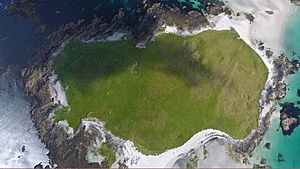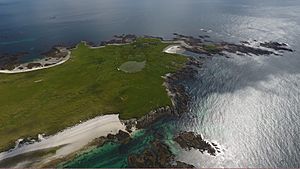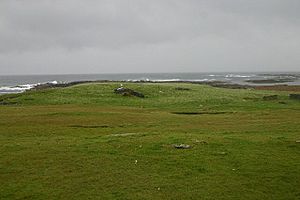Monach Islands facts for kids
Quick facts for kids Monach Isles SSSI |
|
|---|---|
|
IUCN Category IV (Habitat/Species Management Area)
|
|
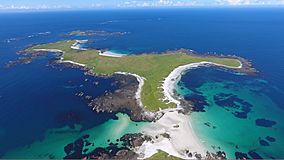
Ceann Iar, the most westerly of the three main Monach Islands
|
|
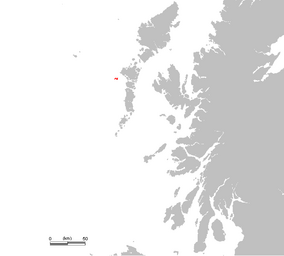
Location of the Monach Islands
|
|
| Location | Outer Hebrides, Scotland |
| Area | 598.1 ha (1,478 acres) |
| Governing body | NatureScot |
The Monach Islands, also known as Heisker, are a group of islands located west of North Uist in the Outer Hebrides of Scotland. These islands are sometimes called Eilean Heisgeir or Heisgeir in Scottish Gaelic. It's important not to confuse them with other islands like Hyskeir or Haskeir, which are also in Scotland.
Contents
Island Features and How They Formed
The main islands in the Monach group are called Ceann Ear, Ceann Iar, and Shivinish. What's really cool is that at low tide, you can walk between all three of these main islands! People even used to say that you could walk all the way from the Monach Islands to Baleshare and then on to North Uist, which is about five miles away, when the tide was out. However, a big tidal wave in the 1600s is believed to have washed away this path.
The Monach Islands are quite flat and sandy. This means they are easily changed by the sea and wind. Some people think that Ceann Iar, Shivinish, and Ceann Ear might have once been one bigger island. Over time, things like too many animals eating the plants, sea floods, and strong winds could have made the land smaller and split it into separate islands.
Besides the main islands, there are also smaller ones like Deasker, Shillay, and Stocaigh.
A Look Back in Time: History of the Islands
The Monach Islands have been empty of people since 1942. But before that, for hundreds of years, up to 100 people lived there. The first time people left was around 1810, possibly because too many animals were eating all the plants. However, by 1841, people started to move back, especially after events like the Highland Clearances where many people lost their homes in other parts of Scotland.
Records from the 1800s show that the number of people living on the islands changed a lot. In 1841, there were 39 people, but by 1891, the population grew to 140 people, which was the most ever.
Lighthouses and Life on Shillay
On the island of Shillay, you'll find the Monach Lighthouse. It was first built in 1864 by David and Thomas Stevenson, who were famous lighthouse builders. This lighthouse was turned off in 1942. But after a big oil tanker called the MV Braer sank in 1993, a new, smaller lighthouse was built in 1997. This new light could be seen from 10 miles away. Later, when a light visible from 18 miles away was needed, the new lighthouse was turned off in 2008, and the old, original lighthouse was fixed up and started working again with a new light. Like all lighthouses in Britain today, it works all by itself without anyone living there.
In 2007, the old schoolhouse on the islands was fixed up. Now, visitors can stay there and learn about the islands' history and the animals that live there. An old boat called the Heisgeir mailboat has also been restored. This wooden boat was built around 1932 for the last family who lived on the Monach Islands. It was found unused and was saved by a local history group.
The Story of Lady Grange
A long time ago, between 1732 and 1734, a woman named Rachel Chiesley, Lady Grange was sent to live on the Monach Isles. Her husband, James Erskine, Lord Grange, who supported the Jacobite cause, had arranged for her to be taken there. At that time, the islands belonged to Sir Alexander MacDonald. Lady Grange lived with a leaseholder and his wife. She was very isolated and didn't even know the name of the island she was on for a while. She complained about her living conditions, but was told she would only get the same simple food and clothes as her hosts. In 1734, she was moved from the Monach Islands. She was told she was going to Orkney, but instead, she was taken to Hirta (part of St Kilda), where she lived for several years before being moved again to Skye, where she later passed away.
Amazing Wildlife and Protecting the Islands
The Monach Islands are very special because of their unique sandy grasslands, called machair, and their large population of grey seals. Every autumn, about 10,000 seals come ashore to have their babies and find mates. This makes it one of the biggest seal colonies in the world!
Many seabirds also nest on the islands, and there are lots of different kinds of plants. You might even see grey herons nesting in some of the old, empty buildings. There are no trees on the islands.
To protect this special place, the Monach Islands have been given several important titles:
- They are a Special Protection Area (SPA) for birds.
- They are a Special Area of Conservation (SAC), which protects important habitats and species.
- They are a Site of Special Scientific Interest (SSSI), meaning they are important for their wildlife and geology.
- A larger area of the sea around the islands was also named a Nature Conservation Marine Protected Area (NCMPA) in 2014. This helps protect the feeding areas for seabirds and the unique shape of the seabed.
These protections help make sure that the Monach Islands remain a safe home for their amazing wildlife.
See also
 In Spanish: Islas Monach para niños
In Spanish: Islas Monach para niños


